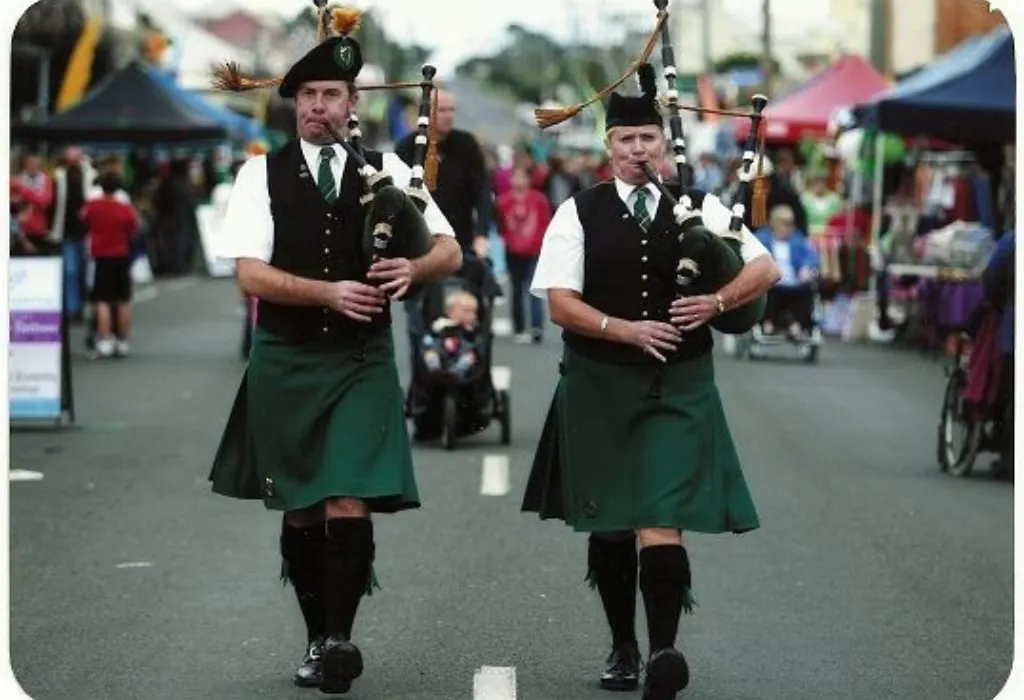Bagpipes are more than just musical instruments; they are cultural icons deeply rooted in the histories of various nations, most notably Ireland and Scotland also part of kilt accessories . This article delves into the intriguing question: Are bagpipes Irish? We uncover the distinct yet intertwined stories of Irish and Scottish bagpipes by exploring their historical evolution, cultural significance, and musical nuances.
Bagpipes as a Cultural Symbol in Scotland
Bagpipes are prominent in Scottish culture, symbolizing national pride and heritage. The skirl of the pipes resonates across Scottish landscapes during celebrations, ceremonies, and military events.
Historically, the bagpipes became synonymous with Scottish identity, especially through iconic types like the Great Highland Bagpipe (GHB) and the Scottish smallpipes.With its stirring tunes like "Amazing Grace" and "Scotland the Brave," the Great Highland Bagpipe has become a global symbol of Scottish music.
Its presence in traditional attire, such as the kilt and sporran, reinforces its cultural significance. Similarly, the Scottish Smallpipes offer a mellower sound, often heard in more intimate settings or alongside other traditional instruments like fiddles and harps.
Difference Between Irish and Scottish Bagpipes
While Irish and Scottish bagpipes share common ground, there are distinct differences. The most notable distinction lies in the specific types of bagpipes used. In Ireland, the Uilleann pipes reign supreme. Unlike the Scottish kilt accessories Great Highland Bagpipe, which is mouth-blown and regulated by arm pressure, Uilleann pipes use bellows and offer a more nuanced, softer tone suited for intricate melodies and slower airs.
Furthermore, the materials used in construction differ slightly between Irish and Scottish pipes. Scottish pipes traditionally feature hardwoods like African blackwood for durability and resonance. In contrast, Uilleann pipes may incorporate softer woods like cocuswood or rosewood. These variations contribute to each type of pipe's unique sounds and playing styles.
Similarities Between Irish and Scottish Bagpipes
Despite their distinct cultural identities, Irish and Scottish bagpipes share several similarities. Both utilize a similar basic design—a wind instrument with a bag, chanter, and drones—but with regional variations in materials and construction.
The musical traditions associated with both include lively jigs, reels, and poignant airs that reflect the landscapes and histories of their respective regions.In Ireland and Scotland, bagpipes have historical connections to military and ceremonial contexts.
They have been used to rally troops, commemorate significant events, and entertain communities during festivities. This shared heritage underscores bagpipes' enduring popularity and cultural resonance across the Celtic nations.
unveiling the History of Bagpipes
The history of bagpipes spans centuries and continents, with evidence of early forms found in ancient civilizations such as Egypt, Greece, and Rome.
The migration of bagpipes into Europe during the Middle Ages influenced their development in regions like Ireland and Scotland, where they became integral to folk music and cultural expression.In Ireland, references to early forms of bagpipes date back to medieval times, with mentions in historical texts and artwork.
The evolution of the Uilleann pipes, characterized by their bellows mechanism and melodic capabilities, represents a distinct Irish contribution to the global family of bagpipes. On the other hand, Scottish bagpipes evolved from earlier European models, adopting unique features that distinguish them within the Celtic music tradition.
Materials That Compose Bagpipes
Traditional craftsmanship plays a crucial role in the construction of bagpipes, ensuring they produce clear, resonant tones while withstanding the rigors of performance.
Irish and Scottish bagpipes rely on specific materials for their acoustic properties and durability. Scottish pipes often feature African blackwood for its density and tonal richness, paired with metals like brass or nickel for the chanter and drone reeds.
In contrast, Uilleann pipes may incorporate softer woods like cocuswood or rosewood, selected for their flexibility and warmth of tone. Metal fittings and mounts add a decorative flair while enhancing the instrument's structural integrity.
Modern innovations in materials and manufacturing techniques continue to shape the evolution of bagpipes, balancing tradition with contemporary demands for reliability and performance quality.
Some facts about bagpipes
Beyond their musical prowess, bagpipes are steeped in intriguing cultural trivia and historical anecdotes. Did you know that the bagpipes were once banned in Scotland following the Jacobite rebellions of the 18th century? This prohibition, intended to suppress Highland culture, ironically fueled a resurgence of interest in Scottish piping traditions during the Victorian era and beyond.
Bagpipes also feature prominently in global popular culture, appearing in films, literature, and music genres ranging from folk to rock. Their distinctive sound has inspired musicians and composers worldwide, showcasing the instrument's adaptability and enduring appeal across diverse musical landscapes.
Whether heard at weddings, festivals, or formal military ceremonies, the bagpipes continue to captivate audiences with their dynamic power and cultural resonance.
Beginner's Essentials for Bagpipe Playing
For aspiring pipers, mastering the bagpipes requires dedication, patience, and a firm grasp of fundamental techniques. Essential equipment includes the bag, typically made from synthetic materials or leather, providing the necessary air reservoir for continuous play.
The chanter, resembling a small flute, produces melody through finger placements on its holes, while drones—typically three in number—add harmonic depth and resonance.Playing the bagpipes involves mastering controlled breathing techniques and developing muscle memory for precise finger movements.
Beginners start with basic exercises and scales before progressing to traditional tunes and ornamentation techniques that characterize Celtic music. Regular practice and guidance from experienced pipers or instructors are essential for honing skills and navigating the instrument's complexities.
Conclusion
In conclusion, while the roots of bagpipes are deeply embedded in Scottish kilt accessories, Ireland has its unique contribution through the Uilleann pipes. Irish and Scottish bagpipes exemplify the enduring appeal of traditional music and cultural expression within the Celtic diaspora.
Whether heard in the rolling hills of Ireland or the misty glens of Scotland, the haunting melodies of bagpipes continue to evoke a sense of heritage and community, bridging past and present through their timeless resonance.
Exploring the rich tapestry of bagpipe history, materials, and musical traditions illuminates their significance as more than mere instruments—they are conduits of cultural identity and artistic expression.
Whether you are drawn to the stirring strains of the Great Highland Bagpipe or the melodic complexity of the Uilleann pipes, one thing remains clear: bagpipes, whether Irish or Scottish, embody the spirit of a people united by music, heritage, and the enduring power of tradition.
FAQs
Bagpipes were banned in Scotland following the Jacobite rebellions of the 18th century to suppress Highland culture, but ironically, this fueled a resurgence of interest in Scottish piping traditions.
Yes, Irish musicians play bagpipes, especially the Uilleann pipes, and some Irish individuals wear kilts, though it’s more commonly associated with Scottish tradition.
The Irish bagpipes are called the Uilleann pipes (pronounced “ill-in” pipes).
Bagpipes are challenging to play due to their complex technique involving simultaneous management of airflow, finger placement, and maintaining consistent pressure in the bag to produce a steady sound.
The exact origins of the bagpipe are unclear, as similar instruments have existed in various cultures for centuries. It’s challenging to attribute its invention to a single person or culture.
Absolutely! There are no restrictions based on gender when it comes to playing bagpipes. Anyone, regardless of gender, can learn and play the bagpipes.




